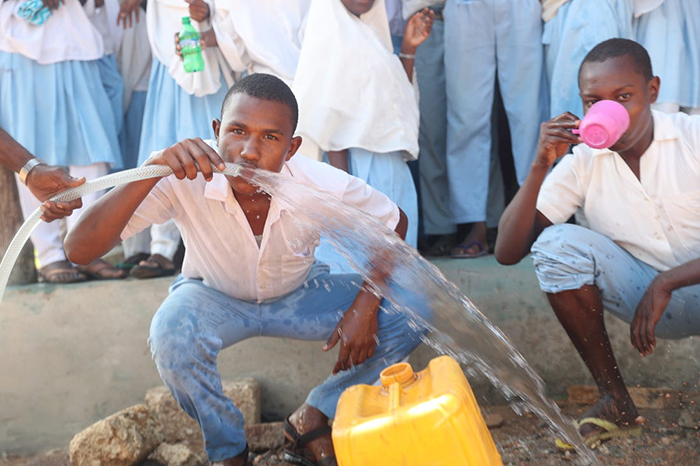- About
- Topics
- Picks
- Audio
- Story
- In-Depth
- Opinion
- News
- Donate
-
Signup for our newsletterOur Editors' Best Picks.Send
Read, Debate: Engage.
| July 24, 2021 | |
|---|---|
| topic: | Renewables |
| tags: | #Africa, #solar power, #renewable energy, #climate crisis |
| located: | Kenya, Morocco |
| by: | Bob Koigi |
Over the years, Africa has grappled with exorbitant prices of conventional power.
In East Africa for example, the average energy price is estimated at 14.8 US cents per kilowatt per hour compared to Canada’s 8.11 US cents per kilowatt per hour. This is despite Canada’s GDP being more than triple that of the East African Community bloc.
Beyond the numbers, clean energy sources have been credited with addressing health concerns associated with fossil fuels, including respiratory diseases, easing pressure on forests, protecting the environment and mitigating the adverse effects of climate change.
The driving force for the renewable energy renaissance in Africa is the burgeoning population, climate change, unprecedented urbanisation, trade and industrialisation, among other competing needs.
With Africa boasting of extensive renewable energy resources, the continent is at a prime position to tap into these resources and drive a global sustainable energy future.
Africa remains the most sun-rich continent in the world, enjoying on average 10 hours of solar each day, and it is this vital resource that it wants to harness in order to meet its energy needs.
The International Energy Agency, IEA, posits that solar photovoltaic energy will contribute 47 percent of all Sub Saharan Africa’s mini grids and off-the-grid power generation systems by 2040.
African governments, private sector entities, multilateral banks and development agencies have championed the adoption of renewable energy, particularly in underserved regions of Africa with a view to enhancing achievement of universal energy access.
Through innovative models including Pay as you go, where beneficiaries pay affordable installments to access power, millions of rural dwellers across Africa now have access to clean energy, which they are using to preserve food in their refrigerators, charge mobile phones and light up schools and households. Furthermore, health centres can now store drugs and vaccines for long, and there has been a marked mushrooming of businesses.
“Since [the] introduction of solar energy in this region three years ago, I have opened small businesses including phone accessories and repair shops, a salon, a small food kiosk and maize milling shop. These businesses have employed about ten people and provided me with income to take care of my family. With access to energy, our region has been awakened and there is a lot of trade going on. A revolution of sorts is now evident in our once sleepy town,” said Caleb Mutiso, an entrepreneur in Eastern Kenya who quit his job to run his businesses after solar mini grids were introduced in his area that had gone for decades without electricity.
Such ‘solar-powered’ towns and villages have sprouted across Kenya as renewable energy companies including BBOXX, Azuri Technologies, M-KOPA, Greenlight Planet, all dealing with solar, scramble to sate the growing appetite for clean and sustainable energy.
Morocco, a harbinger of renewable energy, has built the Noor-Ouarzazate complex, the world's largest solar farm, and now prides itself in owning what has been billed as Africa’s first fully solar-powered village.
Championed by the solar company Cleanergy, the model has been designed to meet the full energy needs of a community by embracing solar. Previously, residents of Id Mjahdi village, located in north western Morocco, relied on tree bark for cooking and heating and on candles for lighting, with candlelight lasting for just about an hour in the evenings.
With the installation of solar photovoltaic panels that generate electricity that is then distributed through a mini grid, households now utilise solar power for their daily energy use, including heating, lighting and preserving food; schools and health centres are able to comfortably meet their needs and there has been an explosion of businesses in the area.
The model has been hailed for its potential to be replicated across Africa and the developing world.
But as Africa savours the clean energy revolution, financing still remains a barrier to reaching millions more who are still underserved. The initial cost of installation of solar photovoltaic panels remains prohibitive, which has threatened scaling ambitions.
The outbreak of COVID-19 has further put a damper on the enterprise. Studies now show that the number of those without access to electricity in Sub Saharan African is likely to grow as a result of the pandemic, as governments dedicate their efforts to tackling the virus.
The global rise in poverty levels now means that those who could previously afford electricity are now unable to, forcing them to go back to dangerous sources like fossil fuels; 30 million of these people are located in Africa, according to an IEA report.
“The onus is therefore on African governments to explore innovative and hybrid funding models that tap into public, private, and donor finances to ensure that the momentum gained in access to renewable energy is maintained if the continent is to meet the growing demand for electricity from a growing population,” notes Thomas Mujimbi, a renewable energy auditor.
Image: Random Institute.
By copying the embed code below, you agree to adhere to our republishing guidelines.

